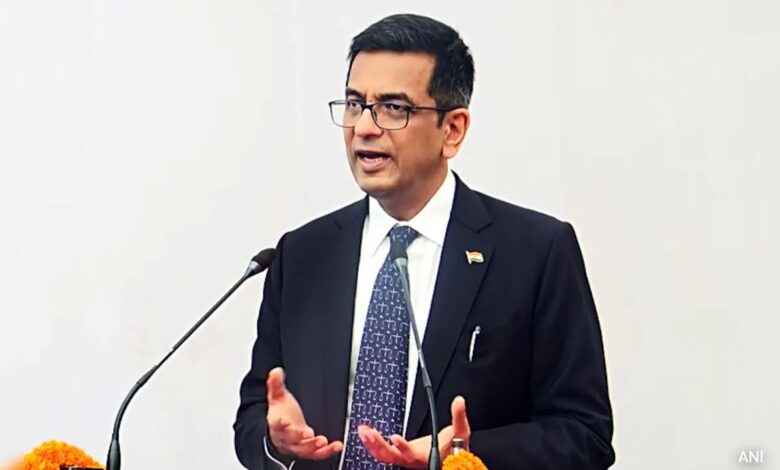
The Chief Justice of India, DY Chandrachud on Thursday said that technology, as we experience it today, is far different from what it was when the Constitution was drafted, adding that the internet and social media and all their attendant applications have rapidly altered the course of life in the last decade.
“Technology, as we experience it today is far different from what it was in the lives of the generation which drafted the Constitution. Information technology, together with the internet and social media and all their attendant applications, have rapidly altered the course of life in the last decade,” CJI said while addressing a memorial lecture on renowned advocate MK Nambyar.
CJI further said that today’s technology renders models of application of a few years ago obsolete.
“Hence, it would be an injustice both to the drafters of the Constitution as well as to the document which they sanctified to constrict its interpretation to an originalist interpretation. In India, we describe the Constitution as a living instrument simply for the reason that while it is a document that enunciates eternal values for Indian society, it possesses the resilience necessary to ensure its continued relevance. Its continued relevance lies precisely in its ability to allow succeeding generations to apply the principles on which it has been founded to find innovative solutions to intractable problems of their times. In doing so, we must equally understand that our solutions must continuously undergo a process of re-engineering,” CJI said while delivering the MK Nambyar Memorial Lecture.
CJI further said that another significant example is the evolution of environmental constitutionalism, which lies at the confluence of constitutional law, international law, human rights, and environmental law.
“The world today stands in a precarious situation. International bodies such as the UN Governmental Panel on Climate Change (IPCC) have raised alarm bells and contend that the impacts of climate change could be irreversible by 2030. The International Organisation on Migration (IMO) estimates that millions of people will be displaced by climate change, potentially causing a climate refugee crisis. The extent of environmental degradation and the very real existential threat caused by climate change was, of course, not foreseeable by the framers of our constitution. However, as the crisis becomes more apparent, courts are increasingly becoming aware of the ramifications of the environmental crisis,” CJI said.
CJI said that the understanding of the Constitution as a living document aids constitutional courts in understanding new, novel problems.
“It also facilitates the Court in finding a jurisprudential basis for solutions to existing social problems. Let’s take the example of Article 17 of the Constitution, which abolishes untouchability. The context of this provision was the stratified society we found ourselves in. Caste was an important axis of social organisation and those who found themselves at the bottom of this occupational, social hierarchy were subjected to untouchability solely on account of their caste,” CJI said.
“The basis, remember, was an occupational hierarchy of castes and ritual impurity associated with certain occupations. The framers of the Constitution debated the scope of this prohibition in some detail. The argument was essentially that if untouchability were not defined and limited in its application to caste, it would lead to unwarranted over-broad application,” CJI said.
It is tempting to pit the framers’ so-called original intent against the notion of living constitutionalism, CJI Chandrachud said as it pointed out that Nambyar demonstrated that the solution lies between a complete abandonment of their vision and its uncritical acceptance.
“While he was meticulous in his understanding of the intent of the framers, he was never overcome by it. For instance, in IC Golaknath, Nambyar relied upon the framers’ intent to secure fundamental rights from parliamentary onslaught. He relied on HM Kamath’s unsuccessful attempt to amend Article 368 to empower the Parliament to alter fundamental rights. Therefore, he argued that there are certain “implied limitations” on the Parliament’s power to amend fundamental rights. Not even hopeful of an admission of the case, Nambyar’s submissions managed to find a place in the dissent of Justice Subba Rao. Then accepted only in part by Justice Subba Rao, Nambyar’s “implied limitations” came to be successfully argued in Kesavananda Bharati by none other than Nani Palkhiwala,” CJI said.
CJI Chandrachud further added that the constitution of a country, which is more than a mere text, is the foundation of this democratic culture and not the culmination of it.
“It merely stems from the framers’ intent, but as Mr Nambyar showed us, it blossoms in the lived realities of its constituents in their specific social contexts. “As we celebrate the legacy of Mr MK Nambyar, we must remember that there were many more like him, who left their imprints on the Constitution, enhanced it, infused it with meaning, and took the texts to its legal destiny,” CJI said.
He said that Nambyar’s story tells us that the story of the Constitution is a constant dialogue between generations of citizens, and this dialogue reflects a dynamic process where each era interprets and applies constitutional principles to contemporary challenges and aspirations, CJI said.
“CJI Chandrachud further added that it highlights how the Constitution evolves through judicial interpretations, legislative amendments, and societal changes, adapting to new contexts while preserving fundamental rights and values. This continuous dialogue ensures that the Constitution remains relevant and responsive, reflecting the collective vision and aspirations of the people across different epochs,” CJI said.
He further said that lawyers play an indispensable role in shaping constitutional discourse.
“While judges have the ultimate authority to interpret the Constitution, it is the lawyers who craft and present the interpretive frameworks for the judiciary to consider. In this sense, interpretation is as much a job of a lawyer as it is of a judge, for without robust legal arguments and advocacy, constitutional interpretation would lack the necessary depth and diversity of perspectives,” CJI said.
(Except for the headline, this story has not been edited by NDTV staff and is published from a syndicated feed.)







